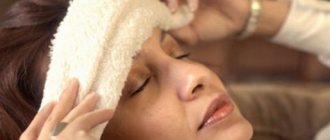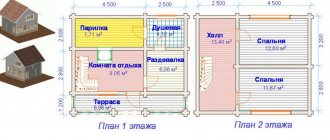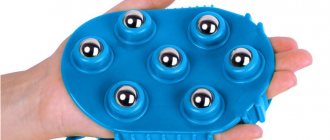Headache after a bath due to a number of different factors. Knowing their complete list, it is easy to prevent serious violations and eliminate their harmful effects. It is important to see a doctor if symptoms do not go away after several days.
How long have you had this pain syndrome?
- Several days (26%, 976)
- First day (21%, 799 Votes)
- Several months (12%, 452)
- Week (10%, 376)
- Several weeks (10%, 358)
- About a month (8%, 312)
- Chronic form (6%, 236)
- About a year (6%, 210)
Total voters: 3 720
Loading …
Use search Are you having a problem? Enter “Symptom” or “Name of the disease” into the form, press Enter and you will find out all the treatment for this problem or disease.
Why does it hurt
Much to the regret of lovers of a real Russian holiday, headaches and nausea after visiting the steam room are a common occurrence.
The main reason for the malaise is the unusual and heavy load on the entire body. The human cardiovascular system does not always adequately respond to sudden changes in external temperature. The body as a whole is experiencing unexpected stress. Chronic illnesses may worsen and symptoms of new problems may appear.
After a bath, pain in the head occurs due to a number of external factors.
- Insufficient oxygen. Many people, while in the steam room, pay attention to the unbearable stuffiness, but most attribute this to the high temperature.
- Carbon monoxide poisoning. Poor ventilation of the bathhouse and the presence of a heating stove are an ideal combination for the accumulation of substances harmful to the body. You can get a burn in the bathhouse even after 5 minutes of stay. Symptoms of carbon monoxide poisoning: headache, nausea, weakness in the limbs and suffocation.
- Incorrect posture. It is important to carry out bathing procedures while lying down; hot air is distributed unevenly in the steam room.
- Heatstroke. Beginners should not steam for long. High temperature and moist steam will often cause overheating.
- Alcohol abuse. Strong drinks overload the body, which is already under severe stress in the sauna.
- Vascular reaction. High temperature is a big burden for all human organs and systems. The walls of blood vessels are especially susceptible to this factor. A long stay in the bathhouse leads to increased blood pressure and a headache.
- Physical exercise. Visiting a steam room after the gym, a long run, or solving many everyday problems can have a bad effect on a person.
- Allergic reaction. The body's sensitivity to various odors also causes headaches. We are talking about brooms, medicinal herbs and essential oils used in the steam room.
The benefits of baths for human health
Traditional Russian steam rooms have long been famous for their beneficial properties for the body. This pastime helps stimulate the nervous system and get rid of accumulated toxins. Experts recommend that adherents of a sedentary lifestyle go to the bathhouse once a week. In just 15 minutes in the steam room, you can restore the function of sore joints and even lose up to one kilogram of excess weight. In addition, steam helps to relax the muscular system.
Congestion in the veins causes great harm to the hematopoietic system. Thanks to a visit to the bathhouse, you can quickly get rid of these ailments. Steam also has a beneficial effect on the functioning of the endocrine glands. Therefore, during the procedures, the functioning of the main systems of internal organs improves.
It is impossible to imagine going to the bathhouse without brooms. Doctors recommend giving preference to birch and oak options. A light massage with brooms has a beneficial effect on all muscle groups. In addition, light pats on the body “drive out” all the salts accumulated in the joints. After one such visit to the steam room, a person feels reborn.
The bathhouse is not always associated exclusively with positive emotions. Many people note that after visiting her, weakness, discomfort and other unpleasant symptoms appear. Some people don’t understand why they get a headache after a bath. The causes of the disorder can be very different, ranging from overheating to bad habits. Let's look at these factors in more detail below.
What causes pain in the morning
Outwardly healthy people may experience painful illness after a relaxing stay in a steam room. This happens due to the heavy load on the body. An irrational approach to the process can result in headaches in the morning and cause the manifestation of various diseases.
The described ailments are more often encountered by people prone to bad habits. Those who are prone to cardiovascular diseases are at risk. Any health problems, especially chronic ones, begin to worsen in the bathhouse.
There are a number of diseases for which visiting a bathhouse is prohibited or undesirable:
- Kidney diseases;
- Stomach and duodenal ulcers;
- Migraine;
- Epilepsy;
- Inflammatory processes of different localization;
- Neoplasms;
- Gallstones.
What to do if you have pain
If you cannot avoid the problem, you need to try to eliminate it. First, you can take a painkiller: Nurofen, Tempalgin, Analgin.
In addition to tablets, herbal infusions based on St. John's wort, lemon balm or elderberry will help cope with pain.
Sometimes it’s enough to go out into the fresh air, lie down in silence, and drink cool water. If headaches appear the next day, rest, drinking plenty of fluids and painkillers will help. You need to measure your blood pressure level.
Which doctor should I contact?
Often, after physical exertion or mental stress, people feel worse. The nature of the pain can be varied. Compressive, pressing, throbbing pain in one side of the head is possible.
Pain during exercise is often functional in nature. They can occur for many reasons:
- Changes in temperature and atmospheric pressure;
- Stressful state during physical activity;
- Heat and stuffiness in the room;
- Dehydration is often the cause of headaches;
- Eat a large meal before training;
- Overweight people often suffer from hypoxia during exercise.
The likelihood of illness is higher in people with specialties: programmer, accountant, driver, who spend many hours at the computer or constantly strain the muscles of the eyes and neck.
Persistent cephalgia, which occurs regularly, requires mandatory consultation with a doctor in order to exclude serious pathology and prescribe the correct treatment in a timely manner.
The initial appointment should be made by a therapist. He will conduct a general examination, measure blood pressure, write out directions for tests and refer you to specialists.
If you have unpleasant sensations in the head and neck area, it is good to have a home blood pressure monitor, with which you can track pressure surges in different life situations. A rise in blood pressure after physical activity can often be the cause of pain.
The doctor gives a referral to an otolaryngologist to rule out chronic otitis media, sinusitis or inflammation of the maxillary sinuses (sinusitis).
The doctor can give a referral to an ophthalmologist to identify changes in the fundus and possible vision defects.
Most of the causes of discomfort in the head are associated with neurological symptoms, so diseases accompanied by head pain syndrome are treated by a neurologist.
What tests are usually prescribed?
At an appointment with a neurologist, a physical examination of the patient is performed: basic neurological reflexes are checked and the neck muscles are examined.
The doctor writes out a referral for tests: general blood test, biochemical blood test, blood sugar test.
A general blood test with an increase in ESR or an increased content of leukocytes indicates inflammation in the body.
Blood biochemistry may indicate a deficiency of one of the vital elements, which leads to discomfort in the head area.
Low blood glucose levels are often accompanied by cephalgia, dizziness and weakness.
The doctor may write a referral for additional tests:
- The gas composition of arterial blood can reveal cerebral hypoxia.
- A blood test for hormones determines various abnormalities in the functioning of the hypothalamus.
A neurologist can give a referral to one or more diagnostic methods:
- Magnetic resonance imaging (MRI) - excludes the presence of various neoplasms (tumors and cysts), aneurysms. The photographs clearly show post-traumatic defects, neurodegenerative abnormalities, and changes in blood vessels affected by atherosclerosis.
- Computed tomography (CT) is the most informative method for studying the brain. It gives a clear idea of pathological changes in the skull and brain, pathology of bone tissue, blood vessels and brain structures. Provides information about the consequences of traumatic brain injuries. The disadvantage of this method is the significant radiation dose during the study.
- Electroencephalography gives an idea of the presence of pathological changes in blood vessels and impaired cerebral circulation.
- Doppler ultrasound (ultrasound of the vessels of the head and neck) - shows the presence of atherosclerotic plaques in the arteries; narrowing and tortuosity of the arteries, leading to brain hypoxia; peripheral vascular resistance.
- Rheoencephalography (REG) - gives an idea of the tone and blood flow of blood vessels. Using REG, the following are diagnosed: hypertension, atherosclerosis, vegetative-vascular dystonia.
- MRI of the cervical spine - the presence of cervical osteochondrosis can cause pain in the head and neck, which intensifies when turning the head.
- Rheovasography of cerebral vessels (RVG) - shows the quality of blood flow through the great vessels, evaluates collateral circulation.
- Radiography will be less known. In the image you can only see the bone structures of the skull, soft tissues are not visible.
There is no need to panic when scheduling such a serious examination. The doctor excludes rare severe pathologies and looks for the causes of the pain process.
Based on the studies, if no serious organic lesions are found, the cause of the disease is usually diagnosed. It develops as a result of: vascular spasms, cerebral hypoxia, hypertonicity of cerebral vessels, hormonal imbalances, vegetative-vascular dystonia or osteochondrosis, provoked by physical or psycho-emotional stress.
Dizzy in the bath
Dizziness occurs for several reasons:
- Blood sugar dropped sharply
- Severe overheating of the brain
- A sharp outflow of blood from the brain
If you feel dizzy in the bathhouse, this is a sure signal that it’s time to end the pleasant procedures. You need to rest in a cool room, cool your overheated body, wipe yourself dry, change clothes and go home to drink tea!
You should not neglect alarming symptoms, because the body itself sends warnings about poor health. If you do not listen to such signals, then more serious consequences are possible, for example, loss of consciousness, fainting.
Safe medications and pills
When planning a visit to the doctor, the patient should be prepared to answer questions about how often pain occurs and what its intensity is. This will help the doctor develop the correct treatment tactics.
Groups of drugs effective for episodic attacks of pain
Medicines for the treatment of pathology are non-steroidal anti-inflammatory drugs (NSAIDs). They have an analgesic effect, relieve inflammation, and eliminate swelling.
Often prescribed:
- Ibuprofen-400 mg per day;
- Ketoprofen-100 mg/s;
- Naproxen-500 mg/s;
- Meloxicam-7.5-15 mg/s;
- Celecoxib-200 mg/s.
Most NSAIDs have a negative side effect: with long-term use, they negatively affect the organs of the gastrointestinal tract, including the development of drug-induced gastritis.
Medicines Meloxicam and Celecoxib are new generation drugs that do not have a negative effect on the gastrointestinal tract. The disadvantages of using these drugs include the relatively high price.
Analgesics are often used at home to relieve an attack. They do not treat the disease, but only relieve pain. Drugs in this group are suitable for stopping episodic attacks, but their systematic use leads to the occurrence of abuse syndrome.
During an attack of pain, you can take Paracetamol-100 mg, Citramon, Analgin-500 mg or Mig 200-400 mg.
If the examination revealed the appearance of cephalgia after exercise as a result of increased blood pressure, the doctor will prescribe medications prescribed at an early stage of the development of hypertension. These include: vasodilators, ACE inhibitors, diuretics, calcium channel blockers.
Self-prescribing antihypertensive drugs is unacceptable. Self-medication leads to serious consequences.
For muscle tension, drugs from the group of muscle relaxants are used as part of complex treatment. They relax the spasmodic muscles of the head and neck, relieving pain of a spastic nature, and help restore blood flow.
Often prescribed:
- Mydocalm-150-450 mg per day;
- Sirdalud (Tizanidine) - 4 mg/s;
- Baclofen-15 mg/s.
Nootropic drugs are often prescribed as part of complex treatment: Phenibut, Nootropil, Glycine. Nootropics have an activating effect on brain function and increase its resistance to damaging factors. The drugs improve cerebral circulation and eliminate the consequences of traumatic brain injuries.
Sedatives in combination with basic drugs lead to muscle relaxation and decreased vascular tone. Taking tranquilizers helps relieve pain, but this type of medication quickly causes drug dependence with withdrawal symptoms.
Sedatives that are not addictive: Afobazol, Atarax; alcohol tinctures of valerian, motherwort, Maryina root.
For severe attacks, a combination of drugs is used: Sirdalud 2 mg + Aspirin 500 mg or Analgin 250 mg + sedative.
The use of vitamin B complexes has proven itself. Vitamins B1, B6, B12 have a beneficial effect on the central nervous system and restore the structure of nerve tissue. Vitamin complexes are often prescribed: Neuromultivit, Milgamma, Neurovitan.
If attacks of pain recur more than 10 times a month, a course of treatment with Ibuprofen at a dose of 400 mg per day for 2-3 weeks and treatment with muscle relaxants is prescribed for 2-4 weeks.
There is no single scheme for pain relief. Depending on the cause, each patient needs an individual selection of drugs.
Treatment of chronic disease
Sometimes cephalalgia becomes chronic. The pain occurs every day, continuously, with varying degrees of intensity.
Tricyclic antidepressants are prescribed for a long course of 2-6 months. They relieve pain and help normalize the psycho-vegetative state of the nervous system.
Amitriptyline 10-100 mg/s is most often prescribed, the dose is increased gradually. The drug relieves pain well, but has many negative side effects and is addictive.
As an alternative, selective serotonin reuptake inhibitors are prescribed: Fluoxetine, Paroxetine, Sertraline. The course of treatment is at least 2 months. These drugs have less toxicity.
In addition to prescribing drug therapy, the doctor will recommend massage, a course of physiotherapy or acupuncture.
Prerequisites for the appearance of chills
Chills are not an independent disease, but just an unpleasant symptom that reduces the quality of life and gives rise to alarming thoughts about the course of the pathological process. It can occur at any age, at first it is unnoticed by others and the patient himself, but soon increases in intensity.
Among the prerequisites for the appearance of chills, it is necessary to highlight the following changes in the patient’s life:
- prolonged hypothermia of the body;
- instability of blood pressure (chronic hypertension);
- stressful situations, shock;
- diseases of the endocrine system;
- ARVI, colds, flu;
- weakened immune system;
- infectious processes.
Since chills, as a symptom, cover many diseases, doctors strongly recommend responding to its appearance even in the absence of high body temperature. This will help speed up diagnosis, ease the course of the disease and ensure a speedy recovery. If you experience a feeling of chilliness, you should immediately consult a doctor - to be on the safe side.
The prerequisites for this symptom are known; now it is necessary to find out what is happening in the body during the course of the pathological process. There may be several scenarios for the development of the clinical picture:
- As a result of prolonged hypothermia
, vascular spasm occurs, the lumen between the vascular walls narrows, systemic circulation is disrupted, and internal processes slow down. Externally, the patient's skin turns blue, and inside he feels chills. - If this is severe emotional stress
, then the spasm is also dangerous for the body, since it can provoke dysfunction of internal organs and systems and is prone to chronicity. The first thing the patient needs to do is calm down, and the same chamomile decoction will help with this. - When hypertensive patients feel chills
, they very quickly get used to this condition and learn to control it independently. Moreover, they consider it a harbinger of another attack of arterial hypertension, so they take vasodilator drugs in a timely manner. - The feeling of chilliness during ARVI
is a protective reaction of the body, which for a sick person should become a kind of hint that conservative treatment should be started immediately. - Hormonal imbalance in the body
also negatively affects the general condition of blood vessels. It is very difficult to get rid of internal chills without fever if the cause of the pathological process is not determined and eliminated. The first step is a biochemical blood test, then replacement therapy. - If an infectious disease progresses,
chills are not the only symptom. The patient feels nauseous, vomiting and diarrhea, and acute migraine attacks are possible. In this way, toxic substances are removed from the body; the presence of temperature during partial intoxication is not necessary. - Another common reason why chills occur without fever is weakened functions of the immune system
. If you strengthen your immune system at home, the unpleasant symptom disappears without medical intervention in a relatively short time.
Having studied the features of this alarming symptom, it becomes obvious that to eliminate chills in some clinical pictures, immediate help from a specialist is needed, while in others, implementing home self-medication methods is quite sufficient. Based on the intensity of symptoms and frequency of relapses, another classification for patients can be determined.











